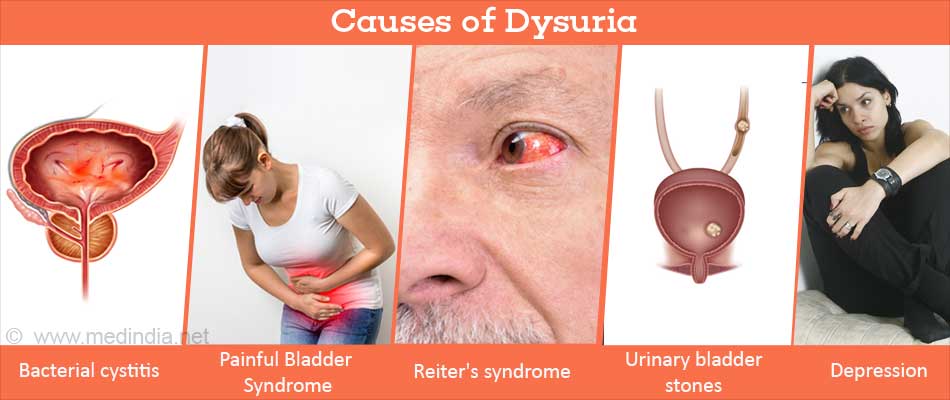- Harrison’s Principles of Internal Medicine 19th edition
What is Dysuria?
Dysuria refers to a feeling of pain or burning while passing urine. It is a common complaint among women, especially in younger ladies who are sexually active; it is often due to an infection of the lower genitourinary tract. It can also occur in men and sometimes the cause maybe difficult to diagnose.
The cause of dysuria can be detected through a detailed medical history and physical examination of the patient. Some uncomplicated cases do not require tests, while others may need a routine urine test, urine culture and a sensitivity test to confirm the diagnosis.
Culture of vaginal or cervical smears can diagnose sexually transmitted diseases in women, while an examination of prostatic secretions can detect infections in males. Tests like ultrasound may be needed for suspected urinary stones.
Treatment of dysuria depends on the underlying cause. Antibiotics along with adequate water intake are used to treat infections. Fungal genital infections are treated with local antifungal drugs. A variety of treatments are needed for conditions like urethral syndrome and interstitial bladder syndrome, where a definite cause cannot be determined.
What are the Causes of Dysuria?
Dysuria causes in both Men and women
Infections: An infection of the genitourinary tract is the most common cause of dysuria in men as well as in women. The short urethra in females makes them more prone to infection, but infection in males is often more difficult to treat. Infections that lead to dysuria include the following:
Dysuria is occasionally experienced during summer when the consumption of water is less and the urine is very concentrated. A concentrated urine is more acidic. Normally the urine pH is on the acidic side and varies from 4.5 to 8 and on an average is about 6. Our kidneys maintain normal acid-base balance by reabsorption of sodium and the tubular secretion of hydrogen and ammonium ions.
Bacterial cystitis: Bacterial cystitis refers to infection of the urinary bladder by gram-negative bacteria like E coli as well as other bacteria like Staphylococcus saprophyticus. The dysuria associated with bacterial cystitis is sudden in onset and associated with increased urgency and frequency of urination. The patient also complains of pain over the bladder just above the pubic region, and may have noted the presence of blood in the urine. Patients respond well to antibiotic treatment. Structural defects of the urinary tract like urethral strictures and bladder diverticula can predispose to the development of bacterial cystitis. Some women develop honeymoon cystitis, that is, bladder infection following sexual intercourse during their early days of marriage.
Urethritis - Common organisms that cause urethritis in both males as well as females include the sexually transmitted organisms Chlamydia trachomatis or Neisseria gonorrhea. While Neisseria gonorrhea urethritisresults in copious and purulent discharge, Chlamydia trachomatis infection causes a mucoid or watery urethral discharge.
Urethral syndrome and Interstitial cystitis (Painful Bladder Syndrome (PBS)): Urethral syndrome and bladder pain syndrome are two very similar conditions where the patient experiences symptoms similar to those caused by a urinary tract infection like increased frequency of urination, pain over the bladder and dysuria. However, an infection cannot be demonstrated on urine tests. The exact cause for the dysuria is not known. Various treatments like lifestyle changes, medications and even surgery has been used to resolve the symptoms.
Urethral syndrome and interstitial cystitis are more common in women. Urethral syndrome is thought to affect about 1 in 4 of all adult women and it is particularly seen in young women. Whereas interstitial cystitis is more common in the age group from 40 to 60 years. Both the conditions are more common among the Caucasians.
The International Continence Society believes that the preferable term for interstitial cystitis should be Painful bladder syndrome. Most patients complain of suprapubic pain related to bladder filling and this is associated with other symptoms such as increased daytime and night-time frequency with absence of proven urinary tract infection or any other pathology. Painful bladder syndrome encompasses a much broader range of causes that need to be excluded including cancer of bladder.
Trauma: Trauma to the genitourinary tract may arise due to several reasons:
- Insertion of a catheter into the urethra to drain the bladder
- Diagnostic and therapeutic procedures like cystoscopy used to study and treat conditions affecting the urinary tract. The patient gives a history undergoing such a procedure
- Following sexual intercourse
Immune-mediated conditions like Behçet's syndrome and Reiter's syndrome cause inflammation, which can also affect the urinary tract and cause dysuria. The patient also reports the presence of other symptoms.
- Behçet's syndrome - Patients with Behçet's syndrome also show symptoms of mouth, skin and genital ulcers, redness of eyes and blurring of vision, and joint pain and swelling.
- Reiter's syndrome - It usually occurs as a consequence of an infection in the body and is characterized by pain in the joints, and inflammation of the eyes and urinary tract.

Exposure to chemicals: Exposure of the lower urinary tract to scented sprays, creams or soaps can result in a local reaction and dysuria. The symptoms resolve once the use of the chemicals is discontinued.
Urinary bladder stones: Urinary bladder stones can cause spasmodic pain and dysuria. The patient may also complain of blood in the urine, and may give a history of previous urinary stones. Diagnosis can be made with the help of an ultrasound. Quite often, small stones pass out of the urethra during urination and may rarely need a procedure for removal.
Lower urinary tract cancers: Lower urinary tract cancers may be rare causes of dysuria but should be kept in mind while diagnosing the cause of dysuria.
Medications: The use of antibiotics like Ticarcillin and Penicillin G, and the anticancer drug Cyclophosphamide are associated with dysuria. Cyclophosphamide causes a condition called hemorrhagic cystitis, where the patient reports blood in the urine. A compound called MESNA can reduce the chances of this side effect.
Psychogenic causes: Psychogenic causes like depression, anxiety or hysteria can also cause dysuria. A careful history and examination and tests to rule out other conditions and to confirm the presence of a psychogenic cause of dysuria can zero down such causes.
Causes of Dysuria in women
Vaginitis or cervicitis in females, ulcers in lower genitourinary tract: Infection of the cervix or the vagina in females may result in dysuria. In contrast to the dysuria produced by bacterial cystitis, the symptoms are more gradual in onset and accompanied to a lesser degree by increased frequency, urgency, pain over the urinary bladder and the presence of blood in urine.
Vaginitis and cervicitis are accompanied by vaginal discharge or irritation. Vaginitis due to a yeast called Candida albicans results in a white discharge. The vaginal discharge following Trichomonas vaginalis vaginal infection has a fishy odor.
Sexually transmitted diseases like herpes simplex damage the inner lining of the genitourinary tract and cause ulcers. The pain during urination may arise when the urine comes in contact with the ulcers. A sexually transmitted disease should be suspected in those with new or multiple sexual partners.
Low estrogen levels: Low estrogen levels following menopause or other conditions like surgical removal of ovaries in women result in thinning of the vagina and possible dysuria. Local estrogen application can help to reduce symptoms.
Dysuria Causes in Men
Bacterial prostatitis in males: The prostate may get infected in males, resulting in dysuria. The patient may also complain of symptoms of increased frequency and urgency of urination, along with pain above the pubic region, in the penis or in the perineum. Bacterial prostatitis is caused by bacteria like E coli and may be acute or chronic. Acute bacterial prostatitis is characterized by the presence of fever or chills, while chronic bacterial prostatitis is characterized by repeated acute attacks of bacterial prostatitis. A pelvic examination should be avoided in acute cases, while prostatic secretion should be obtained following prostate massage to detect the presence of bacteria and white blood cells in the prostatic fluid, thereby confirming the diagnosis. Benign prostatic hyperplasia (BPH) increases the risk for chronic bacterial prostatitis. Patients with BPH also suffer from a weak urinary stream, hesitancy during passing urine and dribbling of urine.

Abacterial prostatitis – In this condition no bacteria is isolated despite repeated examination of the prostatic secretions. The patient complaints of pain in perineum or scrotum or supra-pubic region along with dysuria. This is a difficult condition to treat. Some patients have benefited from microwave therapy of the prostate.
 MEDINDIA
MEDINDIA

 Email
Email










